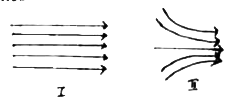Draw a plot showing the variation of (i) electric field (E ) and (ii) electric potential (V) with distance r due to a point charge Q.
To solve the problem of plotting the variation of electric field (E) and electric potential (V) with distance (r) due to a point charge (Q), we will follow these steps:
Step 1: Understand the Formulas
The electric field (E) due to a point charge Q at a distance r is given by the formula:
E=k⋅Qr2
where k is Coulomb's constant.
The electric potential (V) due to a point charge Q at a distance r is given by the formula:
V=k⋅Qr
Step 2: Analyze the Electric Field (E)
- The electric field E is inversely proportional to the square of the distance (r).
- As r approaches 0, E approaches infinity.
- As r approaches infinity, E approaches 0.
Step 3: Plot the Electric Field (E) vs Distance (r)
- On the x-axis, represent the distance (r).
- On the y-axis, represent the electric field (E).
- The graph will be a curve that starts from infinity when r is 0 and approaches 0 as r increases. This will create a hyperbolic shape.
Step 4: Analyze the Electric Potential (V)
- The electric potential V is inversely proportional to the distance (r).
- As r approaches 0, V approaches infinity.
- As r approaches infinity, V approaches 0.
Step 5: Plot the Electric Potential (V) vs Distance (r)
- On the same graph, or on a separate graph, plot the potential (V) against distance (r).
- The graph will also start from infinity when r is 0 and approach 0 as r increases, creating a similar hyperbolic shape.
Step 6: Label the Graphs
- Clearly label the axes for both graphs.
- Indicate which graph represents the electric field (E) and which represents the electric potential (V).
Final Result
You will have two curves:
1. A curve for electric field (E) that decreases rapidly as distance (r) increases.
2. A curve for electric potential (V) that also decreases but at a different rate compared to the electric field.
The electric field (E) due to a point charge Q at a distance r is given by the formula:
E=k⋅Qr2
where k is Coulomb's constant.
V=k⋅Qr
- The electric field E is inversely proportional to the square of the distance (r).
- As r approaches 0, E approaches infinity.
- As r approaches infinity, E approaches 0.
- On the x-axis, represent the distance (r).
- On the y-axis, represent the electric field (E).
- The graph will be a curve that starts from infinity when r is 0 and approaches 0 as r increases. This will create a hyperbolic shape.
- The electric potential V is inversely proportional to the distance (r).
- As r approaches 0, V approaches infinity.
- As r approaches infinity, V approaches 0.
- On the same graph, or on a separate graph, plot the potential (V) against distance (r).
- The graph will also start from infinity when r is 0 and approach 0 as r increases, creating a similar hyperbolic shape.
- Clearly label the axes for both graphs.
- Indicate which graph represents the electric field (E) and which represents the electric potential (V).
You will have two curves:
1. A curve for electric field (E) that decreases rapidly as distance (r) increases.
2. A curve for electric potential (V) that also decreases but at a different rate compared to the electric field.
Similar Questions
The electric field and the electric potential at a point are E and V respectively.
View SolutionShow on a plate the nature of variation of the (i) Electric field (ii) potenital (V), of a (small) electric dipole with the distance (r) of the filed point from the centre of the dipole.
View SolutionDraw a plot showing variation of electric field with distance from the centre of a solid conducting sphere of radius R, having of + Q on its surface.
View SolutionIntensity of an electric field (E) depends on distance r due to a dipole, is related as
View SolutionPlot a graph comparing the variation of potential ‘V’ and electric field ‘E’ due to a point charge ‘Q’ as a function of distance r from point charge
(ii) Find the ratio of the potential differences that must be applied across the parallel and the series combination of two identical capacitors so that the energy stored, in the two cases, becomes the same.
View SolutionObtain an expression for electric potential .V due to a point charge .Q at a distance r.
View SolutionInside a conducting hollow sphere of inner radius R1 and outer radius R2, a point charge q is placed at a distance x from the center as shown in fig. Find.
 .
.
(i) electric potential at C
(ii) electric field and potential at a distance r from the center outside the shell.
View SolutionDrawings I and II show two samples of electric field lines

View SolutionUsing Gauss' law deduce the expression for the electric field due to a uniformly charged sperical conducting shell of radius R at a point (i) outside and (ii) inside the shell.
Plot a graph showing variation of electric field as a function of r>Randr<R. (r being the distance from the centre of the shell)
View SolutionDerive an expression for electric field intensity at a point due to point charge.
View Solution
